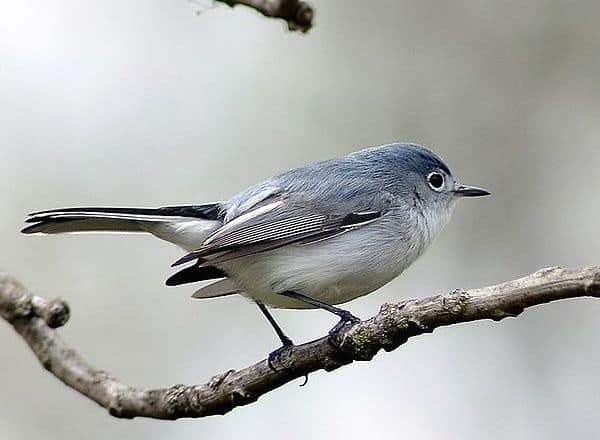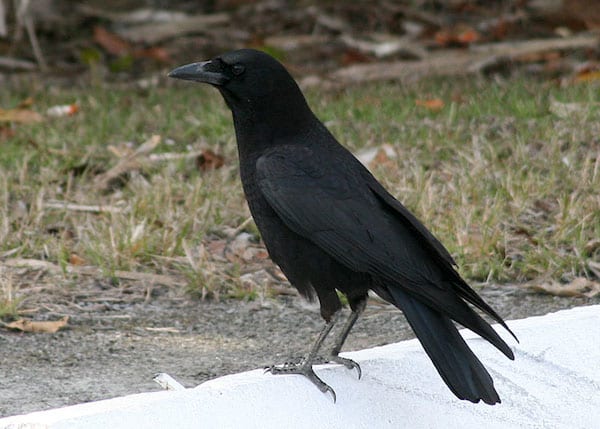Look for
The blue-gray gnatcatcher is the birder’s “mini-mockingbird,” always in motion and usually talking about it. This graceful, delicate, miniscule bird seems to arrive too early in spring, sallying into swarms of midges from still-budding branches.
Its slender, elongated form and flashy black-and-white paneled tail are hard to mistake, though the gnatcatcher often goes unnoticed. A white eye ring and neat black eyeline, blue-gray upperparts, and a long, slender tail edged in white distinguish this elegant bird. Females are similar, but lack the black eyeline.
Listen for
It’s often the gnatcatcher’s twangy, whining call—like a miniature banjo being tuned—that alerts us to its presence. Its song is a sputtering, wheezy, petulant-sounding jumble, punctuated by mews. The blue-gray gnatcatcher has been recorded mimicking other species, a talent not widely appreciated, perhaps because its high, whispery voice is beyond the hearing register of many bird watchers.
Find It
It’s most likely to be spotted on its early spring migration, for it is a woodland denizen, often hidden by foliage after the trees leaf out. Blue-gray gnatcatchers are strongly associated with oaks in a wide range of habitats, sticking to woodlands dominated by broad-leaved species.
They are more often seen along woodland edges than in yards and gardens, except during migration. Gnatcatchers winter in the western coastal scrub of Mexico and Central America.
Feeding Behavior
Perching on the outer twigs in the mid- to high canopy, gnatcatchers go out after flying insects or glean the outer foliage for insects and spiders. As they forage, they flick their white outer tail feathers, which is thought to create bursts of light that startles UV-sensitive insects into flight. The bill is a fine black forcep, good for grasping tiny prey.
Nesting Behavior
Gnatcatcher nests are often mistaken for those of hummingbirds, being neat, compact cups of silk (often gathered from tent caterpillar nests), plastered with lichens. They are usually saddled on a horizontal limb. It is often possible to witness construction because the male gnatcatcher escorts the nest-building female with much fanfare and conversation.
Both male and female incubate four eggs for 13 days, and young birds leave the nest 13 days after hatching. They are still being fed by their parents three weeks after departing the nest but gain independence soon thereafter.
WOW!
Many consider the arrival of the blue-gray gnatcatcher a better sign of spring than the first American robin. Gnatcatchers appear in many areas as soon as small insects become active.





I’ve been watching and photographing these birds throughout July and August from my deck in Aurora, IL. We live in a subdivision surrounded by Big Woods forest preserve to the east and south of us and Fermilab (Fermi National Accelerator Laboratory) across the street to the north. The thing is, they spend time in our neighbor’s birch trees. I actually got a few photos of one flying from the tree and landing on the back of one of our deck chairs, about 5 feet from me! The reason I am saying this is that from what I’ve read in the “Find It” section above, “They are more often seen along woodland edges than in yards and gardens”. https://uploads.disquscdn.com/images/5692abeb09e7ff704d51da3282e4f2472b6015ae4fb95060ce24a76adbe72e89.jpg https://uploads.disquscdn.com/images/eca4ad1c51cd737f90ac4202c55db7355e3d7a65b64897b56267e5ffe479640a.jpg https://uploads.disquscdn.com/images/2c9d07d4ad3ada4acaa27338c176e3c1ae936348ead8d3d7f3f142213a87ac44.jpg https://uploads.disquscdn.com/images/3964724caf186973616a3dc8aa318af40beba97804c3ae5583b14aa04d9fde78.jpg https://uploads.disquscdn.com/images/34f1e8198309dc1abac271118cd6bb2520a9342f10a10c5e7d8c086718b9ad27.jpg